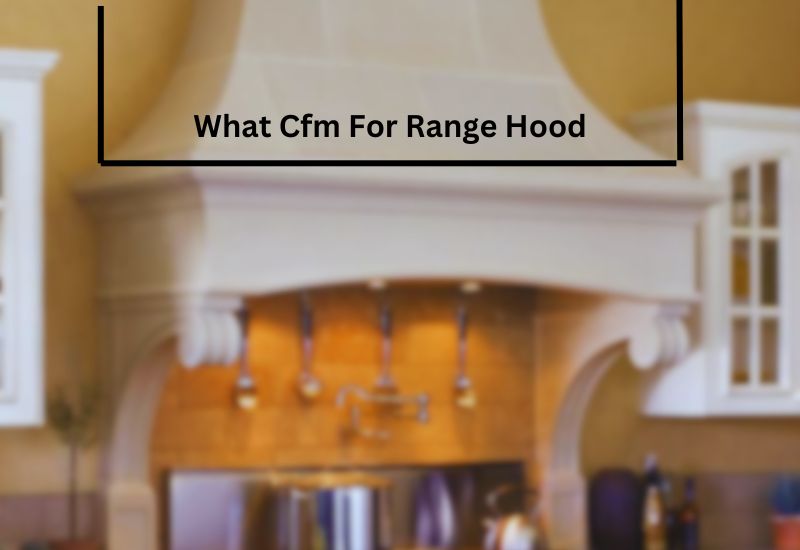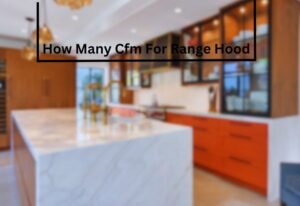If you’ve ever cooked up a storm in your kitchen, you’re likely familiar with the clouds of steam, odors, and smoke that can fill the air. This is where a range hood comes to the rescue! A range hood is a crucial appliance that helps keep your kitchen air clean and fresh by venting out all those unwanted byproducts of cooking. One key factor that determines the efficiency of a range hood is its CFM, or cubic feet per minute, rating.
What Cfm For Range Hood? The required CFM (cubic feet per minute) for a range hood depends on the size and type of your cooking area. Generally, for effective ventilation, aim for a CFM rating of 1 CFM per 100 BTUs of your stove’s heat output. For example, a 40,000 BTU stove would need a 400 CFM range hood.
CFM measures the amount of air a range hood can move in a minute, indicating its suction power. Choosing the right CFM for your range hood is essential to ensure effective ventilation, preventing grease buildup, odors, and maintaining a comfortable cooking environment. Let’s dive into the world of CFM for range hoods and discover how to select the right one for your kitchen’s needs.
Understanding CFM in Range Hoods
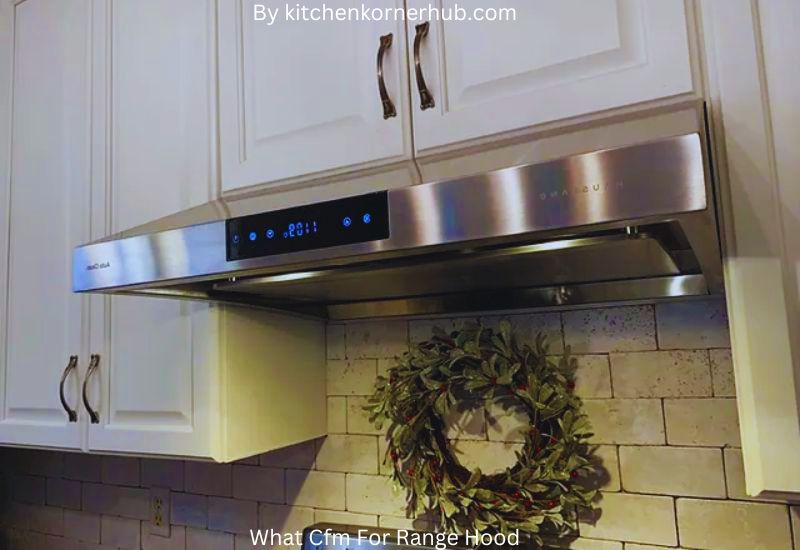
Range hoods are essential appliances in kitchens, serving the vital role of ventilating cooking areas by removing smoke, odors, and grease. One of the most critical aspects that determine the efficiency of a range hood is its CFM (cubic feet per minute) rating. CFM refers to the volume of air that a range hood can move in one minute. Understanding CFM is crucial in choosing the right range hood for your kitchen, as it directly impacts the performance of the ventilation system.
Importance of CFM Rating
The CFM rating of a range hood is a direct indicator of its extraction capability. A higher CFM indicates a more powerful motor and better capacity to handle intense cooking processes, such as searing and frying, which produce a significant amount of smoke and steam. Opting for a range hood with an adequate CFM rating ensures that the air in your kitchen is efficiently cleared, promoting a cleaner and healthier cooking environment.
Factors Influencing CFM Requirements
Several factors influence the CFM requirements of a range hood for a specific kitchen setup. The size of the kitchen plays a pivotal role; larger kitchens necessitate higher CFM ratings to ensure effective air circulation. Additionally, the type of cooking you do matters. If you frequently engage in high-heat cooking techniques, like wok cooking or grilling, a range hood with a higher CFM rating becomes essential due to the increased volume of pollutants produced.
Calculating the Appropriate CFM
Calculating the appropriate CFM for your kitchen involves a simple formula: multiply the kitchen’s square footage by the recommended air changes per hour (ACH). Typically, the ACH recommendation ranges from 10 to 15, meaning the air in the kitchen should be completely exchanged 10 to 15 times in an hour. For example, a 150 square foot kitchen with a recommended ACH of 12 would require a range hood with a CFM of at least 180 (150 sq ft * 12 ACH / 60 minutes).
Balancing CFM and Noise
While a high CFM rating ensures effective ventilation, it’s essential to strike a balance between performance and noise level. Range hoods with higher CFM ratings can be louder due to the powerful motor required to move the air. Modern range hoods often incorporate noise-reduction technologies, like insulated motor housings and variable speed settings, allowing users to adjust CFM levels according to their cooking needs while keeping noise at a comfortable level.
Factors Influencing CFM Requirements

When it comes to determining the required Cubic Feet per Minute (CFM) for various applications, several crucial factors come into play. CFM, a measure of airflow, holds significant importance in industries ranging from HVAC systems to pneumatic tools. The CFM requirements are not fixed and can vary significantly based on a range of influencing factors.
Application Type and Purpose:
The type of application directly influences CFM requirements. Different applications, such as ventilation systems, spray booths, or air compressors, have distinct needs for airflow. For instance, industrial processes involving hazardous fumes demand higher CFM rates to ensure effective air exchange and safety. Similarly, cooling or heating systems in residential buildings or commercial spaces need CFM calculations tailored to achieve optimal comfort levels and energy efficiency.
Space Volume and Size:
The size of the space being ventilated or conditioned plays a vital role in determining CFM requirements. Larger spaces require higher CFM rates to ensure adequate air distribution. A room’s cubic volume directly impacts how quickly air needs to be circulated to maintain comfortable conditions or remove pollutants effectively. Overlooking this factor could lead to insufficient airflow, resulting in uneven temperature distribution or poor indoor air quality.
Environmental Conditions:
The prevailing environmental conditions in and around the space also impact CFM requirements. For instance, an industrial facility located in a hot and humid climate requires a more substantial CFM to manage excessive heat and moisture. Similarly, areas with high levels of airborne contaminants or pollutants demand increased CFM rates to maintain acceptable air quality standards.
Air Exchange Rate and Occupancy:
The desired rate of air exchange and the number of occupants in a space are key considerations for determining CFM needs. Spaces with high occupancy, such as auditoriums or gymnasiums, require higher CFM rates to provide sufficient fresh air for the occupants. Moreover, spaces with specialized requirements, like hospital operating rooms demanding sterile environments, need precise CFM calculations to maintain desired air quality standards.
Equipment and Machinery:
The presence of equipment, machinery, or processes generating heat or pollutants impacts CFM requirements. In industrial settings, certain machinery can emit heat, gases, or particulate matter, necessitating higher CFM rates for effective ventilation and maintaining worker safety. Cooling equipment, such as data center air conditioning systems, require accurate CFM calculations to prevent overheating and ensure optimal performance.
Calculating CFM for Kitchen Size

A crucial aspect of designing an efficient kitchen ventilation system is determining the appropriate CFM (Cubic Feet per Minute) rating for the space. The CFM value indicates the volume of air that a ventilation system can move in a minute, and getting this calculation right ensures proper air circulation, removal of cooking odors, and elimination of harmful pollutants. Several factors come into play when calculating the CFM for a kitchen size, making it a multi-dimensional process that demands careful consideration.
Understanding the Kitchen’s Size and Layout
The first step in calculating CFM is assessing the kitchen’s dimensions and layout. Measure the length, width, and height of the kitchen to determine its cubic footage. This measurement gives an initial indication of the volume of air that needs to be circulated. Consider the layout as well – an open-concept kitchen may require higher CFM to effectively capture cooking fumes that can spread across the living space.
Factoring in Cooking Equipment
The type and size of cooking equipment used in the kitchen significantly impact the CFM calculation. Larger and more powerful appliances generate higher levels of heat and cooking byproducts, necessitating increased ventilation. For instance, a commercial-grade stove will demand more CFM compared to a standard residential cooktop. Factoring in the BTU (British Thermal Unit) ratings of the appliances helps determine the amount of heat produced and pollutants generated during cooking.
Determining Air Exchange Rate
The air exchange rate specifies how many times the air within a room should be replaced in an hour. For kitchens, a minimum of 15 air changes per hour is recommended to ensure thorough removal of cooking odors and contaminants. Multiply the kitchen’s cubic footage by the desired air exchange rate to obtain an initial CFM value. However, keep in mind that this is a general guideline; higher cooking intensity or special requirements might necessitate a higher air exchange rate.
Accounting for Hood Efficiency
Kitchen ventilation systems often incorporate range hoods to capture and expel cooking fumes. The efficiency of the hood is a critical consideration when calculating CFM. Look for range hoods with a capture efficiency rating of at least 90%. This means the hood can effectively capture 90% of the generated pollutants. Adjust the CFM calculation based on the hood’s efficiency to ensure that the desired air quality is achieved.
Consulting a Professional
While the aforementioned steps provide a good starting point, accurately calculating CFM for kitchen size can become intricate due to the interplay of various factors. When designing a ventilation system for a commercial kitchen or a kitchen with unique requirements, it’s wise to consult a professional HVAC (Heating, Ventilation, and Air Conditioning) engineer. They possess the expertise to perform detailed calculations, taking into account factors like ductwork, system losses, and local building codes.
Matching Cooking Styles with CFM Ratings
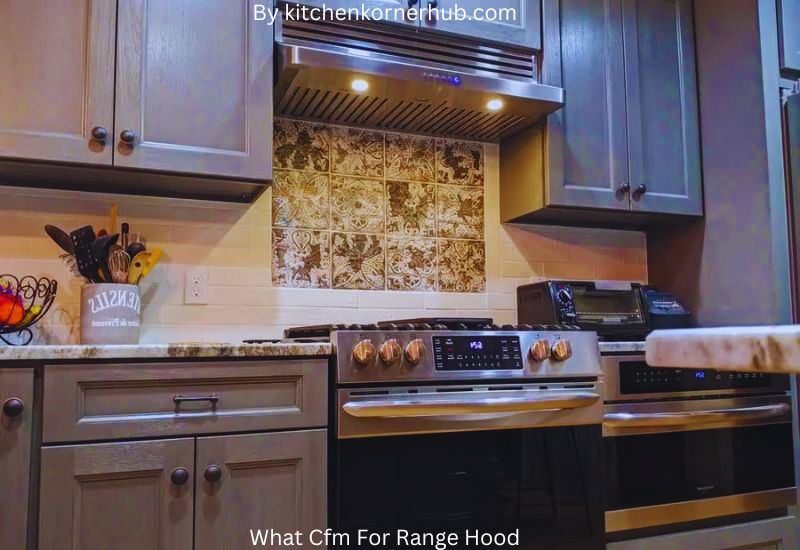
In the realm of modern kitchen design, the importance of efficient ventilation cannot be overstated. The CFM (Cubic Feet per Minute) rating of a range hood plays a pivotal role in ensuring that cooking fumes, odors, and excess heat are effectively removed from the kitchen space. However, it’s not just about selecting a range hood with the highest CFM; rather, it’s about aligning the CFM rating with your specific cooking style to optimize functionality and comfort.
Understanding CFM Ratings:
CFM stands for Cubic Feet per Minute, and it measures the amount of air a range hood can move in a minute. A higher CFM rating indicates greater air extraction capacity. It’s crucial to understand that the ideal CFM rating depends on factors like the size of your kitchen, the heat output of your cooking appliances, and your cooking habits.
Cooking Styles and CFM Requirements:
Different cooking styles produce varying levels of smoke, steam, and odors. If you’re an occasional cook who mostly uses the stovetop for light cooking, a range hood with a lower CFM rating (around 150-300 CFM) might suffice. However, if you frequently engage in high-heat cooking techniques like searing and stir-frying, or if you have a large, open kitchen, a range hood with a higher CFM rating (400-800 CFM or more) would be more suitable to handle the increased airflow demands.
Tailoring CFM to Kitchen Size:
The size of your kitchen is a key determinant when matching CFM ratings. In smaller kitchens, excessive CFM might lead to an uncomfortable draft, while insufficient CFM in a larger kitchen could result in poor ventilation. It’s recommended to have a professional assess your kitchen’s dimensions to ensure an optimal CFM rating for efficient air exchange without compromising on comfort.
Noise Considerations:
While higher CFM ratings offer better ventilation performance, they can also lead to increased noise levels. If you’re concerned about noise, opt for range hoods with variable speed settings. This way, you can adjust the CFM as needed – lower when light cooking is underway and higher during intense cooking sessions. Modern range hoods also come equipped with noise reduction technologies, allowing you to strike a balance between performance and tranquility.
Energy Efficiency and Sustainability:
Selecting the right CFM rating isn’t just about comfort; it’s also about energy efficiency. A range hood that’s overpowered for your cooking style wastes energy and increases utility costs. Conversely, an underpowered hood might require extended operation, also consuming more energy. By aligning the CFM rating with your cooking habits, you contribute to a more sustainable kitchen environment and lower energy bills.
High CFM vs. Low CFM Range Hoods
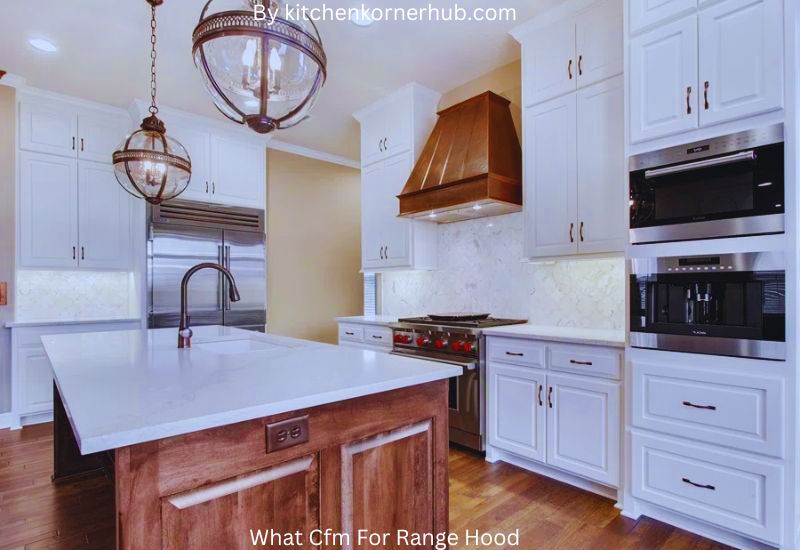
Range hoods play a crucial role in maintaining a clean and odor-free kitchen environment by effectively removing smoke, steam, grease, and other airborne particles generated during cooking. One of the most important factors to consider when choosing a range hood is the cubic feet per minute (CFM) rating, which indicates the unit’s airflow capacity. The debate between high CFM and low CFM range hoods centers on their respective advantages and limitations, catering to different kitchen setups and cooking styles.
High CFM Range Hoods: Powerhouse Performance for Intensive Cooking
High CFM range hoods, typically ranging from 600 CFM to over 1200 CFM, excel in kitchens where heavy-duty cooking is common. These hoods are well-suited for professional chefs or avid home cooks who frequently engage in activities like frying, grilling, and stir-frying, which release substantial amounts of smoke and grease. High CFM hoods efficiently capture and expel these pollutants, preventing them from accumulating on surfaces and maintaining air quality. However, their increased power might lead to louder operation and potentially higher energy consumption.
Low CFM Range Hoods: Efficiency and Moderation for Everyday Cooking
Low CFM range hoods, usually ranging from 150 CFM to 400 CFM, are a suitable choice for kitchens where cooking is less intense and predominantly involves basic stovetop tasks. These hoods are designed to remove moderate amounts of steam and odors, making them ideal for apartments or homes with limited ventilation options. Additionally, low CFM hoods are generally quieter and consume less energy than their high CFM counterparts. While they might struggle to handle heavy smoke and grease, they strike a balance between functionality and efficiency for everyday cooking.
Ventilation Needs and Kitchen Layout: Tailoring CFM Selection
The choice between high and low CFM range hoods should also be influenced by the kitchen’s layout and ventilation requirements. Larger kitchens with open designs might benefit from high CFM hoods as they can effectively circulate air over larger areas. In contrast, smaller kitchens or those with limited ventilation might find low CFM hoods adequate, given their focused performance. Additionally, considering the ducting setup and the distance between the range and the exterior wall can guide the appropriate CFM choice for optimal performance.
Balancing Noise and Performance: High CFM vs. Low CFM
A notable consideration when comparing high CFM and low CFM range hoods is the noise level. High CFM hoods, due to their powerful motors, tend to produce more noise during operation. This can be a concern in open-concept living spaces where a quieter environment is desired. Low CFM hoods, on the other hand, offer a quieter experience, making them suitable for homes where noise might be an issue. Finding the right balance between performance and noise is crucial to ensure the range hood enhances the cooking experience without causing disruptions.
Energy Efficiency and Environmental Impact
The energy consumption of a range hood is a concern for both environmental reasons and utility bills. High CFM hoods, while effective in heavy-duty cooking scenarios, might consume more energy. This can impact overall energy efficiency and contribute to higher costs over time. Low CFM hoods, being more energy-efficient, align better with sustainable practices and are favored by homeowners aiming to reduce their carbon footprint.
Conclusion
In conclusion, selecting the appropriate CFM (cubic feet per minute) for a range hood is a crucial decision to ensure effective ventilation in the kitchen. Factors such as the size of the cooking area, cooking habits, and the type of stove play a significant role in determining the ideal CFM rating. Striking the right balance between adequate air movement and noise level is essential for a comfortable and efficient kitchen environment. By considering these factors and consulting with experts, one can make an informed choice that promotes a healthier cooking space and enhances overall air quality.
Frequently Asked Question(What Cfm For Range Hood)
Is 450 CFM enough for range hood?
A range hood with a 450 CFM (cubic feet per minute) airflow rate can be suitable for moderate cooking needs in a residential kitchen. It’s generally effective in removing smoke, steam, and odors from the air while cooking.
However, if you frequently cook dishes that produce heavy smoke or strong odors, or if you have a larger kitchen space, you might consider opting for a higher CFM rating for more efficient ventilation.
Is 600 CFM good for range hood?
A range hood with a 600 CFM (cubic feet per minute) airflow rate is generally considered to be quite effective for most residential kitchens. This level of airflow is suitable for a variety of cooking styles and can handle a range of cooking odors and grease.
It’s a good balance between performance and energy efficiency. A 600 CFM range hood should be more than adequate for most home cooking needs.
What is 1200 CFM mean?
A CFM (cubic feet per minute) rating of 1200 indicates a very powerful and high-capacity ventilation system. In the context of a range hood, a 1200 CFM rating means that the hood can move 1200 cubic feet of air every minute.
This level of airflow is typically found in professional-grade kitchens or in homes where cooking involves heavy frying, grilling, or other high-heat methods that generate substantial amounts of smoke, steam, and odors. It ensures efficient removal of pollutants from the air and maintains a comfortable cooking environment.
What does 400 CFM mean?
A CFM (cubic feet per minute) rating of 400 refers to the airflow capacity of a ventilation system, such as a range hood. In the context of a range hood, a 400 CFM rating indicates that the hood can expel 400 cubic feet of air every minute.
This level of airflow is suitable for moderate cooking activities in a residential kitchen. It can effectively remove common cooking byproducts like steam and light odors, making it a practical choice for everyday home cooking.
Is 500 CFM range hood enough?
When it comes to choosing the right range hood for your kitchen, the question of whether 500 CFM (Cubic Feet per Minute) is enough depends on various factors. First and foremost, you need to consider the size of your kitchen and the cooking appliances you use. In smaller kitchens with less powerful stovetops, a 500 CFM range hood can provide adequate ventilation to remove cooking odors, smoke, and grease effectively. However, if you have a larger kitchen or a high-powered range, you might want to consider a range hood with a higher CFM rating, as it can provide better airflow and more efficient ventilation.
Another essential factor to think about is the type of cooking you do. If you frequently cook dishes that involve high-heat cooking methods like frying or grilling, or if you often have multiple burners going at once, a higher CFM range hood might be more suitable. It helps to ensure that the hood can effectively capture and exhaust the increased smoke and heat generated during such cooking processes.
Does higher CFM mean quieter?
The CFM (Cubic Feet per Minute) rating of a range hood does not directly correlate with its noise level. In most cases, higher CFM does not mean quieter. In fact, as the CFM rating increases, the range hood typically becomes noisier due to the increased airflow and fan power required to move more air. This is because a higher CFM range hood has a more robust motor and fan system to effectively capture and exhaust smoke, odors, and heat from the cooking area.
To achieve a quieter kitchen environment, you should look for range hoods that have noise-reduction features and technology. Some range hoods come equipped with sound insulation, variable fan speed settings, and even special noise-reduction design elements. These features can help mitigate the noise generated by a high CFM range hood, allowing you to balance ventilation performance with a quieter cooking experience.

